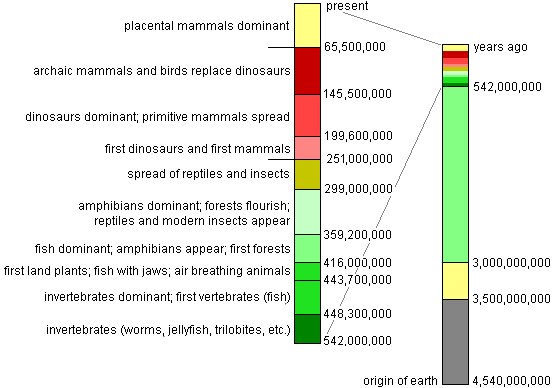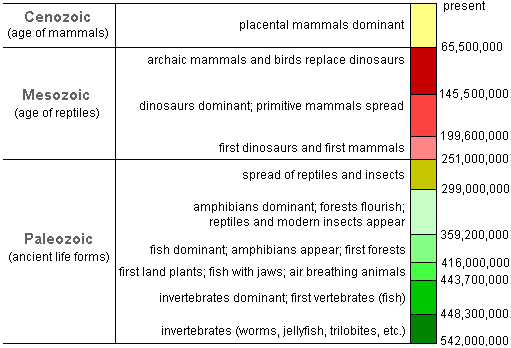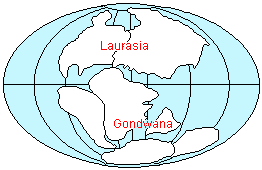When did the earth form?
When did life begin? When did humans and the other primates first appear?
Reasonably accurate scientific answers to these questions did not develop until the
1960's and 1970's when radiometric dating techniques were invented that
could date
samples that are billions of years old. However, before the 1960's, scholars in many
cultures tried to estimate the age of the earth and of life.
 |
| James Ussher 1581-1656 |
In the past,
estimates often were based on counts of generations of people in sacred texts.
Manetho
![]() , an ancient Egyptian historian, listed all of the
dynasties of pharaohs and gods that reigned down to his time (3rd century B.C.). This
made the earth about 38,000 years old (from our time). In the early 17th century
A.D., James Ussher
, an ancient Egyptian historian, listed all of the
dynasties of pharaohs and gods that reigned down to his time (3rd century B.C.). This
made the earth about 38,000 years old (from our time). In the early 17th century
A.D., James Ussher
![]() ,
the Anglican Archbishop of Armagh in
Northern Ireland, accepted the
Judeo-Christian Old Testament as being literally true and subsequently determined
the age of the earth by counting biblical generations and adding their time to
modern recorded history. With this method, he
calculated that the creation was in 4004 B.C. on October 23 (about 6,000 years ago).
,
the Anglican Archbishop of Armagh in
Northern Ireland, accepted the
Judeo-Christian Old Testament as being literally true and subsequently determined
the age of the earth by counting biblical generations and adding their time to
modern recorded history. With this method, he
calculated that the creation was in 4004 B.C. on October 23 (about 6,000 years ago).
|
|
|
| Edmond Halley
F.R.S. 1656-1742 |
With the rapid growth of
European scientific knowledge, largely beginning in the late 17th century A.D., it became
increasingly clear that the earth must be much more than a few thousand years old.
Some scientists abandoned the theological approach and began to devise methods for
determining the age by measuring natural phenomena. In 1691, the British astronomer
and mathematician Edmond Halley
![]() proposed that if the original
oceans were fresh water, one could calculate the minimum age of the earth by dividing the
total amount of salt now present in the oceans by the amount added each year from the
world's rivers and streams. Those water sources bring with them mineral
salts eroded from the land. While he actually did not have the full necessary data
available, Halley used this approach to conclude that the earth is minimally 100,000,000
years old.
proposed that if the original
oceans were fresh water, one could calculate the minimum age of the earth by dividing the
total amount of salt now present in the oceans by the amount added each year from the
world's rivers and streams. Those water sources bring with them mineral
salts eroded from the land. While he actually did not have the full necessary data
available, Halley used this approach to conclude that the earth is minimally 100,000,000
years old.
 |
|
|
William Smith |
In 1785, the Scottish geologist James Hutton proposed that different layers of rock came from specific periods of geologic time. Further, he observed that the layers that were deeper down were older. In 1799, the English canal and mine engineer William "Strata" Smith expanded on this idea of geologic time by dividing sedimentary rock layers that he observed in Britain into 6 main divisions based, in part, on the fossil evidence of life that they contained:
| Geologic Era | Fossil Forms Present | ||
|---|---|---|---|
|
|
|
||
| Cenozoic | recent life forms (age of mammals) | ||
| Mesozoic | middle life forms (age of reptiles) | ||
| Paleozoic | ancient life forms | ||
| Proterozoic | early life forms | ||
| Archaeozoic | beginning life forms | ||
| Azoic | no life forms |
These main divisions, or eras, proposed by William Smith became the basic framework for the geologic time scale of the earth that we still use today. Smith also created the first detailed geologic map of England and Wales. Since this was the first map of its kind, he is now thought of as the father of geology.
By the mid
19th century, some geologists were estimating the amount of time for the
successive
changes in animal species found as fossils in the sedimentary rock
layers identified by William Smith. It was wrongly assumed that species
evolve at a steady, measurable rate. If that were true, it would be
possible to measure the thickness of all known fossil bearing strata and
multiply it by a presumed constant evolution rate to determine the total
amount of time passed. The English geologist
Charles Lyell
![]() used this approach in 1867 to estimate that life had been on
earth for
about 240,000,000 years. This estimate was made 8 years after
Charles Darwin
used this approach in 1867 to estimate that life had been on
earth for
about 240,000,000 years. This estimate was made 8 years after
Charles Darwin
![]() published his book On the Origin of Species, which described how
natural selection can result in the evolution of new species.
published his book On the Origin of Species, which described how
natural selection can result in the evolution of new species.
Still another flawed method for estimating the age of the earth was devised by Lord Kelvin (William Thomson) in 1862. Based on the laws of thermodynamics and the assumption that the entire earth was entirely molten at the beginning, he calculated how long it would have taken for the near-surface rock to cool to the temperature it is now. This led him to conclude that the earth must be 20,000,000 to 400,000,000 years old. However, he neglected to take into account the fact that some heat from the earth's core is regularly conducted to the crust. He also was unaware of the fact that intense heat is still being produced inside the earth by radioactive decay.
 |
|
 |
||
| Charles Lyell 1797-1875 |
Lord Kelvin 1824-1907 |
Charles Darwin 1809-1882 |
Despite their revolutionary implications, these and other early scientific estimates for the age of the earth and of life were, in fact, far too small. We now know that the earth is approximately 4.54 billion years old and that there have been living things on our planet for at least 3.5 billion years.
Modern
Methods of Dating the Earth
Modern methods of dating the earth and the major events in the evolution of life depend on understanding radioactive decay processes. Certain radioactive isotopes in rocks are the driving mechanisms for reliable "atomic clocks." For instance, uranium-238 decays through several steps into lead-206. The rate at which this occurs is fixed by the uranium-238 half-life of approximately 4.5 billion years. In 1905, the American chemist Bertram Boltwood realized that the age of an ancient rock could be determined by carefully measuring the relative amount of these two isotopes in a sample. By 1907, he had dated the oldest rocks that he could find with this method. Based on this work, he concluded that the earth must be at least 2 billion years old.
|
This link takes you to a video at an external website. To return here, you must click the "back" button on your browser program. (length = 1 mins, 39 secs) |
By the early 1960's, the decay rates of many other elements had been discovered and were beginning to be used for radiometric dating. Geologists began looking seriously for the earliest piece of the earth's crust. We now know that rocks dating to 3.5 billion years are relatively common and are found on all continents. The oldest still intact rock found so far is from the eastern shore of Canada's Hudson Bay. It dates to 4.28 billion years but is not part of the earth's primordial crust. Rather, it is a piece of greenstone that probably formed by precipitation in a deep sea hydrothermal vent. Still older are zircon crystals found in sedimentary rock from Western Australia. These date to 4.36-4.38 billion years. They are not intact original crust material either. The rock from which they originated eroded, and the individual particles became part of the later sedimentary rock that was sampled. It is unlikely that we will ever find an intact piece of the original earth. Erosion and other geological processes long ago recycled the first crust. In any case, our planet is almost certainly somewhat older than that solid crust because the surface of the early earth was molten rock.
Most astronomers believe that the numerous asteroids and smaller rock objects orbiting our sun, primarily between Mars and Jupiter, were created at about the same time as the earth. Since these bodies lack molten cores and are too small to have atmospheres, it is probable that they are still more or less as they were when they were formed. Periodically, some of them are pulled out of orbit by comets and crash into the Sun. On rare occasions, the earth gets in the way, and these rock bodies strike our planet. Remnants of such meteors that have been dated with multiple radiometric methods range in time from 4.29 to 4.58 billion years, with most of them near the older end of this range. Based on these dates, the U.S. Geological Survey has estimated that the earth is most likely about 4.54 .02 billion years old. Supporting this estimate are the radiometric dates for rocks brought back from the moon by the Apollo missions of NASA in the early 1970's. The oldest moon rocks are 4.29 to 4.56 billion years old. Most astronomers believe that the moon coalesced out of debris from the earth that was thrown into space by the impact of a massive asteroid or small planet that struck the early earth.
|
This link takes you to an external website at the U.S. Geological Survey. To return here, you must click the "back" button on your browser program. |
Before continuing, you may wish to download and print out the table linked by the following button. This will help you better relate the time scale of the major events of biological evolution on earth.
Evolution
of Life
 |
The earth experienced heavy bombardments of asteroids and comets around 3.9 billion years ago. These devastating impacts of thousands of large space objects very likely went on for 20-200 million years and probably contributed to the development of oceans and an early atmosphere that included water vapor but not much free oxygen. Presumably, the water mostly came from the ice of comets and trapped in salt crystals in meteorites. It has been suggested that these events could have resulted in the necessary conditions for the appearance of life.
The earliest signs of life on earth consist of organic chemicals (specifically, cholesterol) that were produced by single-celled microscopic organisms. These chemicals have been found in rock from western Greenland dating to 3.7-3.9 billion years ago. However, this evidence is not convincing to some researchers because it consists of the chemical markers of life rather than actual cells. Much more credible have been the discovery of fossil colonies of single-celled microscopic organisms dating to 3.4-3.5 billion years ago in Australia and South Africa. Assuming that the beginning of life on earth occurred about that time or a bit earlier, we must conclude that our planet was lifeless for its first billion or so years.
By 3-3.5 billion years ago, large colonies of
photosynthesizing blue-green algae
![]() were very likely
flourishing near the surface of oceans and seas. By 2.4 billion years
ago, they apparently were producing enough
oxygen to begin transforming our planet's atmosphere
to one suitable for the oxygen breathing creatures that would later evolve. In
addition, more complex single-celled organisms with nuclei were now common. The most
advanced creatures were sponges,
which are essentially intermediate between single and multi-celled organisms.
By 2.1 billion years ago, there were early simple multicellular organisms
living in shallow marine environments.
Research done by S. Blair Hedges of Pennsylvania State University suggests
that the evolution of life accelerated with the appearance of
mitochondria around 1.8 billion
years ago. Hedges estimates that the split between what eventually
would become the plant and animal lines of evolution occurred about 1.6
billion years ago. By 1.5 billion years ago, there were simple
creatures with up to 10 different kinds of eukaryotic cells. By 1
billion years ago, their descendents had up to 50 different kinds of cells.
were very likely
flourishing near the surface of oceans and seas. By 2.4 billion years
ago, they apparently were producing enough
oxygen to begin transforming our planet's atmosphere
to one suitable for the oxygen breathing creatures that would later evolve. In
addition, more complex single-celled organisms with nuclei were now common. The most
advanced creatures were sponges,
which are essentially intermediate between single and multi-celled organisms.
By 2.1 billion years ago, there were early simple multicellular organisms
living in shallow marine environments.
Research done by S. Blair Hedges of Pennsylvania State University suggests
that the evolution of life accelerated with the appearance of
mitochondria around 1.8 billion
years ago. Hedges estimates that the split between what eventually
would become the plant and animal lines of evolution occurred about 1.6
billion years ago. By 1.5 billion years ago, there were simple
creatures with up to 10 different kinds of eukaryotic cells. By 1
billion years ago, their descendents had up to 50 different kinds of cells.
Complex multicellular forms of life are surprisingly recent on our planet. They have existed only for about 600,000,000 years or slightly more. When these creatures began to appear, 87% of the earth's existence had already gone by, and 83% of the total time life has existed had already passed as well.
|
Time table of the evolution of complex life forms on earth
|
 |
During the Paleozoic Era
![]() (ca. 542-251 million years ago), there was a
comparatively rapid evolution of complex life forms, including plants, invertebrates
(ca. 542-251 million years ago), there was a
comparatively rapid evolution of complex life forms, including plants, invertebrates
![]() , and vertebrates
, and vertebrates
![]() . In addition, life moved onto the land for the first time.
This dramatic explosion of biological diversity began around 550-542 million
years ago. What made it possible was a huge increase in the
amount of oxygen in the atmosphere and the oceans at that time.
Evidence suggests that atmospheric oxygen levels rose from 3% to the modern
level of 21%. The increased oxygen concentration made it possible for
animals to become larger. During the Mesozoic
Era
. In addition, life moved onto the land for the first time.
This dramatic explosion of biological diversity began around 550-542 million
years ago. What made it possible was a huge increase in the
amount of oxygen in the atmosphere and the oceans at that time.
Evidence suggests that atmospheric oxygen levels rose from 3% to the modern
level of 21%. The increased oxygen concentration made it possible for
animals to become larger. During the Mesozoic
Era
![]() that followed (ca.
251-65.5 million years ago), mammals
first appeared, but large reptiles dominated the planet. This was the age of
dinosaurs. With the end of the last dinosaurs around 65,500,000 years ago, the
Cenozoic
Era
that followed (ca.
251-65.5 million years ago), mammals
first appeared, but large reptiles dominated the planet. This was the age of
dinosaurs. With the end of the last dinosaurs around 65,500,000 years ago, the
Cenozoic
Era
![]() began and more advanced
mammals rapidly evolved and
became the dominant large animals. It was only in this last geologic era that
primates evolved. The earliest human species first appeared about 2.5 million years ago. By then,
99.9% of the earth's history had already occurred and most kinds of creatures had become
extinct.
began and more advanced
mammals rapidly evolved and
became the dominant large animals. It was only in this last geologic era that
primates evolved. The earliest human species first appeared about 2.5 million years ago. By then,
99.9% of the earth's history had already occurred and most kinds of creatures had become
extinct.

The evolution of life has not been a smooth process of ever increasing numbers of species. There have been major setbacks caused by global catastrophic events such as ice ages, immense volcanic eruptions, asteroid impacts, and major fluctuations in the amount of oxygen in the atmosphere. The result has been at least six episodes of mass extinction and many minor ones.
|
Approximate date
of extinction event |
Approximate duration (years) |
Percent of species that became extinct |
||
|---|---|---|---|---|
| 65,500,000 (end of Mesozoic Era) | <1 million | 76% | ||
| 200,000,000 (end of Triassic Period) | 3-4 million | 80% | ||
| 251,000,000 (end of Permian Period) | unknown | 95-96% | ||
| 360,000,000 (late Devonian Period) | <3 million | 83% | ||
| 444,000,000 (end of Ordovician Period) | 10 million | 85% | ||
| 488,000,000 (end of Cambrian Period) | unknown | unknown | ||
| (Source: Gibbs, W. Wayt (2001) "On the Termination of Species", Scientific American Vol. 285, No. 5). | ||||
As a result of each of these extinction episodes, there was an opening up of new opportunities for the relatively few surviving species. As older, often dominant creatures disappeared from the scene, others took advantage of the biological vacuum and rapidly diversified through adaptive radiation. For instance, the abrupt end of the last dinosaurs 65,500,000 years ago allowed the placental mammals to rapidly evolve into the numerous species lines of today and to become the dominant large animals. Primates, rodents, dogs, cats, hoofed animals, and sea mammals all appeared and became major players in most environments around the globe.
|
This link takes you to a HHMI webpage. Once there, select "Watch The Day The Mesozoic Died". To return here, you must click the "back" button on your browser program. (length = 33 mins, 44 secs) |
There is reason to believe that we are now in the midst of a 7th major global extinction event. This one began 10-15,000 years ago as the last ice age was coming to an end. Several hundred large animal species have already become extinct, and many others are threatened. The continuing explosion of our human population has played a major role in this.
Evolution
of the Continents
The
earth's lithosphere
![]() (the outer rock shell) consists of
8 enormous rigid plates and
many smaller ones. All of these plates are moving more or less constantly
relative to each other at a rate of a few centimeters a year--about the rate
at which fingernails grow. Some are moving slower and others more
rapidly. Driving this tectonic movement is magma welling up
from within the planet. Most of the earth's volcanic and earthquake activity occurs where plates
collide.
These dynamic processes result in lateral shifting of the plates and mountain building. Over tens of
millions of years, tectonic movement has
caused the continents to travel thousands of miles and to alter their shapes.
This process is also referred to as continental drift.
It is now known that all of the continents came together and fused early in the time of
the dinosaurs. This super-continent has been named
Pangaea
(the outer rock shell) consists of
8 enormous rigid plates and
many smaller ones. All of these plates are moving more or less constantly
relative to each other at a rate of a few centimeters a year--about the rate
at which fingernails grow. Some are moving slower and others more
rapidly. Driving this tectonic movement is magma welling up
from within the planet. Most of the earth's volcanic and earthquake activity occurs where plates
collide.
These dynamic processes result in lateral shifting of the plates and mountain building. Over tens of
millions of years, tectonic movement has
caused the continents to travel thousands of miles and to alter their shapes.
This process is also referred to as continental drift.
It is now known that all of the continents came together and fused early in the time of
the dinosaurs. This super-continent has been named
Pangaea
![]() (Greek for "all of the earth"). It began forming about 285
million years ago. It was complete by about 210 million years ago and began drifting
apart again 10 million years later.
(Greek for "all of the earth"). It began forming about 285
million years ago. It was complete by about 210 million years ago and began drifting
apart again 10 million years later.
 |
 |
|
| 225,000,000 years ago | 125,000,000 years ago |
Pangaea was massive enough to radically change the world's climates. The interior of this super-continent would have been far enough from oceans to have extreme seasonal swings in temperature much greater than today. However, its coastal areas were probably tropical to subtropical and more conducive to animal life. Intense tectonic movements due to the squeezing together of the continental plates around 250 million years ago triggered massive volcanic activity which would have blocked out the sun with fine ash for years. Some researchers believe that this would have cooled the earth's surface sufficiently to trigger a long, devastating ice age. Others propose that carbon dioxide from the volcanoes would have caused intense, prolonged global warming and a subsequent poisoning of the oceans and much of the lower atmosphere with hydrogen sulfide gas. Supporting both of these hypotheses is the fact that there was at least a million cubic kilometers of lava that flowed over the surface of what is now Siberia about 250 million years ago. This period coincides with the most complete extinction episode known. Only about 4% of all plant and animal species survived. We almost lost life on our planet. It took about 10 million years for biological diversity to recover following this genetic bottle-necking. The major animal beneficiaries were the dinosaurs and other reptiles. By 200 million years ago, the primitive mammals first appeared.
|
This link takes you to a QuickTime video. To return here, you must click the "back" button on your browser program. (length = 2 mins, 20 secs) |
NEWS: In the November 7, 2011 issue of the journal Science, Shu-zhong Shen et.al. reported that their extensive dating of well preserved sedimentary rock strata at sites in South China and Tibet show that the mass extinction at the end of the Permian Period lasted less than 200,000 years with its peak at 252.28 million years ago. They concluded that 95% of marine life and 70% of terrestrial life around the globe went extinct with most species dying off during a 20,000 year period. If these new dates are correct, it means that the earlier determination of 250-251 million years ago for the end of Permian extinction is incorrect.
Copyright
1999-2014 by Dennis
O'Neil. All
rights reserved.
illustration
credits

